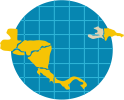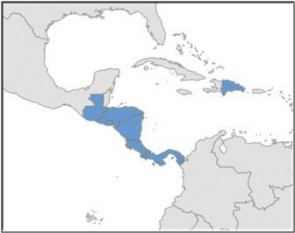The Convention on International Trade in Endangered Species of Wild Fauna and Flora (CITES) is an international agreement between 180 States that aims to ensure that international trade in specimens of wild animals and plants does not threaten their survival. This report is designed to provide an overview of trade in CITES-listed species, as recorded by seven Parties in their annual reports to CITES: Costa Rica, Dominican Republic, El Salvador, Guatemala, Honduras, Nicaragua and Panama (Figure 1; hereafter referred to as “the Region”). These seven countries are all included in free trade agreements with the United States of America (hereafter referred to as the United States): the Dominican Republic–Central America Free Trade Agreement (CAFTA-DR) and the U.S.–Panama Trade Promotion Agreement (Panama TPA or Panama FTA).
The report comprises six chapters: 1) overview of trade in CITES-listed species; 2) an analysis of species showing noteworthy patterns of trade in wild specimens; 3) shifts in trade; 4) inconsistencies in reporting; 5) overview of trade in species native to the Region that are traded at notable levels by other CITES Parties and 6) a preliminary valuation of trade in CITES-listed species by the Region.
As highlighted within the report CITES at 40: Perspectives, trade patterns and future prospects[1], CITES is virtually unique amongst the multilateral biodiversity conventions in its extensive data holdings and compilation of primary data. The CITES Trade Database, managed for the CITES Secretariat by UNEP-WCMC, currently contains over 13 million trade records representing reported trade in CITES-listed species over almost 40 years. These data provide the basis for monitoring the implementation of the Convention and support key decision making. Analysis of trade data can also highlight any areas of potential concern and the need for increased capacity building.
The aim of this report is to provide some key summary messages to inform future trade management in the Region, as a contribution to the capacity development programme supported by the U.S. Department of Interior. Ensuring effective implementation of CITES can support legal and sustainable trade, providing benefits for both livelihoods and the environment.
This report provides an analysis of trade data recorded by the Parties in the Region, and trading partners, in their annual reports to CITES. All trade data submitted by Parties in their annual reports to CITES are available for download via the CITES Trade Database. The analysis includes all terms, units[1], purposes and sources recorded in trade, unless otherwise specified. Conversion factors were applied to the data to standardise certain terms and units in order to facilitate analysis.
The primary focus of the analysis is on direct exports by the Region as reported by the seven countries over the period 2003-2012; direct export transactions account for 96% of the 30,464 total export transactions from the Region (direct exports and re-exports). Imports by the Region and trade recorded by trading partners are also highlighted throughout, where relevant. Analysis of trade data as reported by both trading partners can help to give a clearer picture of the trade, for example, if one partner fails to submit an annual report (resulting in an under-estimation of trade volumes) or reports on the basis of permits issued rather than actual trade (potentially resulting in an over-estimation of trade volumes). Other potential causes of discrepancies between exporter- and importer-reported data are explored further here.
In order to provide a broad overview of the character of trade from the Region, taking into account the fact that trade is recorded in a variety of different types of commodity and in different units, certain sections of the analysis focus on the number of trade transactions recorded within CITES annual reports (as reflected in the CITES Trade Database) to give an indication of trade levels. It is important to note that the number of transactions does not provide any indication of the quantity of items in trade; for example, one transaction may involve the export of 100 live Iguana iguana, while another may involve the export of 500 cubic meters of Swietenia macrophylla timber. Where trade volumes are characterised on the basis of numbers of transactions as opposed to quantities of items in trade, this is clearly stated.
[1]Throughout the analysis, where trade is described without a specified unit (e.g. 100 leaves), the quantity refers to the number of individual items in trade.
Trade data used in the analysis were extracted from the CITES Trade Database initially on 24th October 2013 and were updated on 13th December 2013 to include any additional CITES annual reports for 2012 received. At the time of data extraction (13th December 2013), three countries in the Region had not yet submitted their annual reports to CITES for 2012; a further six annual reports have not yet been submitted for years in the period 2003-2011 (Table 1).
Table 1. CITES annual reports for countries in the Region over the period 2003-2012 available at the time of analysis (13 December 2013).
| 2003 | 2004 | 2005 | 2006 | 2007 | 2008 | 2009 | 2010 | 2011 | 2012 | |
|---|---|---|---|---|---|---|---|---|---|---|
| Costa Rica | ✓ | ✓ | ✓ | ✓ | ✓ | ✓ | ✓ | ✓ | ✓ | ✓ |
| Dominican Republic | x | ✓ | x | ✓ | ✓ | ✓ | ✓ | ✓ | ✓ | ✓ |
| El Salvador | ✓ | ✓ | ✓ | ✓ | ✓ | x | ✓ | ✓ | ✓ | ✓ |
| Guatemala | ✓ | ✓ | ✓ | ✓ | ✓ | ✓ | ✓ | ✓ | ✓ | x |
| Honduras | ✓ | ✓ | ✓ | ✓ | ✓ | ✓ | ✓ | ✓ | ✓ | ✓ |
| Nicaragua | ✓ | ✓ | ✓ | ✓ | ✓ | ✓ | ✓ | x | x | x |
| Panama | ✓ | ✓ | ✓ | ✓ | ✓ | ✓ | x | ✓ | ✓ | x |
The following terminology is used to aid readability of the report, but requires some explanation. The terms “exporter” and “importer” refer to countries of export and countries of import, respectively. In accordance with CITES Notification No. 2011/019, the word “term” refers to the description of a particular item in trade, as reported in CITES annual reports (for example, “live” or “meat”); items in trade are referred to in the report generically as “commodities”. In several instances the “top commodity” or “top taxon” in trade are referred to, meaning the commodity or taxon traded in the highest number of units, respectively; whether they be numbers of live animals, cubic metres of timber or kilograms of meat. Explanations of CITES source and purpose codes, as defined in Resolution Conf. 12.3 (Rev. CoP16) on Permits and Certificates, are included in the Glossary. The term “captive-produced” is used in the report to refer collectively to source codes ‘A’, ‘C’, ‘D’ and ‘F’.
Throughout the report, decimal separators are represented by a full stop (.) and thousand separators are represented by a comma (,).
[1] CITES CoP16 Inf. 35.

